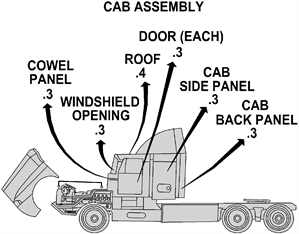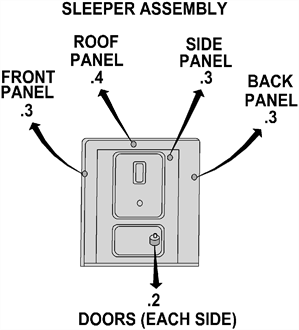Refinish Time Premise
The Mitchell refinish times and subsequent overlap calculations are predicated on the application of a "single" color to replaced components. Should it be necessary to mix, set-up or tint a color for a secondary application other than two stage or three stage, the time associated with these operations should be estimated accordingly. (see not included section of procedure P-24 refinish).
Complete Refinish
Refinish times in this Guide pertain to NEW, UNDAMAGED PARTS and are not intended for calculating complete vehicle refinish—single- or multi-stage. An estimate of this nature would suggest all new panels have been fitted to the vehicle.
Lifetime Refinish Warranty/Clear Coat
The major paint manufacturers listed below have provided the following information: "Major refinish paint manufacturers recommend that when performing refinish warranty repairs on an OEM multi-stage or basecoat/clearcoat finish, you must extend the application of clear to the nearest panel edge or breakpoint to qualify for lifetime warranty." AKZO —
Repaired/Used Panels
Labor times related to repaired and/or used panels—example: Remove and install or masking of glass, outside handles or exterior trim, feather prime & block, masking for primer surfacer application—are not included in refinish time. The steps required for refinishing a repaired and/or used panel may vary from those required for a new panel depending on the condition of the repaired and/or used panel.
Feather, Prime & Block
Is the Not-Included refinish operation that completes bodywork repair from 150 grit smoothness to the condition of a new undamaged panel, and the point at which refinish labor time begins. The labor and materials associated with feather, prime and block may vary depending upon the size of the repair area, and should be evaluated when determining the work to be performed. See Welded Panels under Estimating Information.
SPOT REPAIR/BLEND ADJACENT PANEL
Spot Repair
Spot repair is defined as applying color to the repaired area of a damaged panel to obtain full coverage of undercoats, and blending that color into the original panel finish so that no transition can be detected. The goal is to keep the actual repair as small as possible to avoid having newly applied color directly next to an undamaged adjacent panel(s). Clear coat is then applied to the entire panel. This refinish process minimizes color mismatch.
Blend for Color Match
Blending is defined as applying color, without necessity to cover undercoats, to less than the full surface area of an adjacent undamaged panel. Paint manufacturers recommend blending adjacent panels when a panel is replaced, or repaired and color applied to the full surface areas, or to the area that borders the adjacent undamaged panel(s). Clear coat is then applied to the entire blended panel.
Major Panels
Major panels are those listed: FRONT HEADER, COWL SIDE, DOOR, ROCKER, ROOF, CAB CORNER, CAB BACK, SLEEPER FRONT, SLEEPER SIDE, SLEEPER ROOF, SLEEPER CORNER, SLEEPER BACK
Mask Vehicle to Prevent Overspray Damage
The following refinish information is provided should it be necessary to perform these operations as determined by individual job requirements:
MASK INTERIOR, ENTRYWAYS, AND ENGINE COMPARTMENT OPENINGS
Interior masking may be necessary when refinishing exterior surfaces to stop overspray damage that is not prevented by adjacent panel perimeter masking which includes back taping or application of foam tape. Interior masking may also be used when exterior panels (door, hood, etc.) are removed while applying refinish material. The performance of this operation is NOT INCLUDED in the Mitchell refinish labor time.
Fig. 1: IDENTIFYING INTERIOR MASKING LOCATIONS


NOTE: The times shown in the illustration are for interior masking of that panel and/or opening. Labor time includes all pillars, jambs, weatherstrips, edges, entryways and openings as necessary. Deduct .1 hour overlap for each interior masked adjacent panel and/or opening.
EXAMPLE 1: If refinishing the Hood on the truck along with other adjacent panels, the suggested labor time for masking Cowl Panel could be used to mask the opening between Hood and Cowl.
EXAMPLE 2: If refinishing the Hood on the truck only, the labor time for masking/bagging entire truck .3